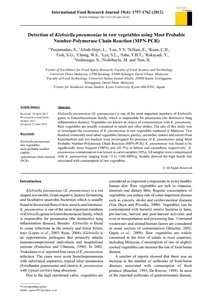Citation
Puspanadan, Soopna and Loo, Yuet Ying and Nillian, Elexson and Kuan, Chee Hao and Goh, Sur Guat and Chang, Wei San and Lye, Ying Ling and Afsah-Hejri, Leili and Tang, John Yew Huat and Rukayadi, Yaya and Nakaguchi, Yoshitsugu and Nishibuchi, Mitsuaki and Radu, Son
(2012)
Detection of Klebsiella pneumoniae in raw vegetables using most probable number-polymerase chain reaction (MPN-PCR).
International Food Research Journal, 19 (4).
pp. 1757-1762.
ISSN 1985-4668; ESSN: 2231-7546
Abstract
Klebsiella pneumoniae (K. pneumoniae) is one of the most important members of Klebsiella genus in Enterobacteriacae family, which is responsible for pneumonia (the destructive lung inflammation disease). Vegetables are known as source of contamination with K. pneumonia. Raw vegetables are usually consumed in salads and other dishes. The aim of this study was to investigate the occurrence of K. pneumoniae in raw vegetables marketed in Malaysia. Two hundred commonly used salad vegetables (lettuces, parsley, cucumber, tomato and carrot) from hypermarkets and wet markets were investigated for presence of K. pneumoniae using Most Probable Number-Polymerase Chain Reaction (MPN-PCR). K. pneumoniae was found to be significantly more frequent (100%) and (82.5%) in lettuce and cucumbers, respectively. K. pneumoniae contamination was lowest in carrot samples (30%). All samples were contaminated with K. pneumoniae ranging from <3 to 1100 MPN/g. Results showed the high health risk associated with consumption of raw vegetables.
Download File
![[img]](http://psasir.upm.edu.my/40959/1.hassmallThumbnailVersion/Detection%20of%20klebsiella%20pneumoniae%20in%20raw%20vegetables%20using%20most%20probable%20number-polymerase%20chain%20reaction%20%28MPN-PCR%29.pdf)  Preview |
|
PDF
Detection of klebsiella pneumoniae in raw vegetables using most probable number-polymerase chain reaction (MPN-PCR).pdf
Download (434kB)
| Preview
|
|
Additional Metadata
Actions (login required)
 |
View Item |

